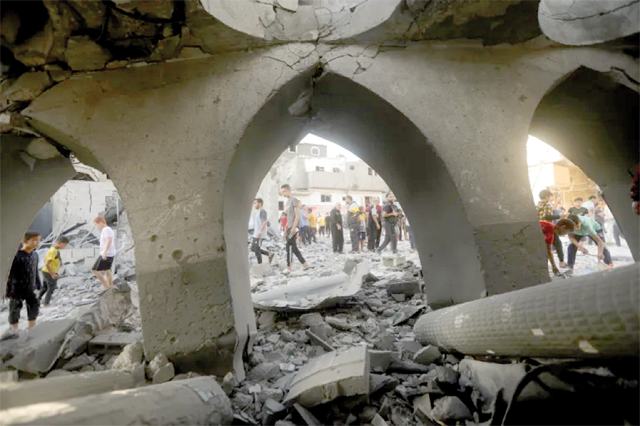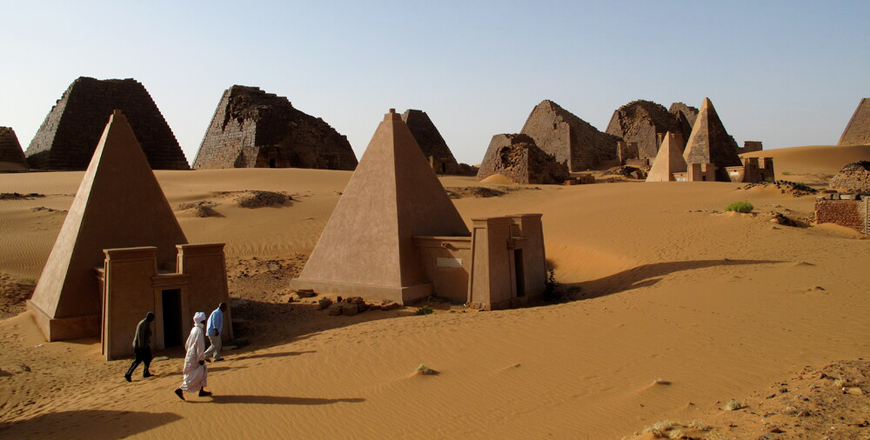You are here
Cultural damage assessment in war-torn Gaza
By Sophie Constantin - Aug 06,2024 - Last updated at Aug 06,2024

Mosques, churches and heritage sites are among the places damaged and destroyed in Gaza (AFP Photo)
AMMAN – Amidst the unfolding tragedy in Gaza, international organisations have released detailed reports on the deliberate destruction of Palestinian cultural heritage by Israeli forces.
Culture heritage encompasses archaeological sites, historical monuments, artefacts, archives and museums, which are all valuable for their historical, scientifical, aesthetic, religious and architectural significance. These elements serve as symbols of collective identity and are tangible links to the past.
Salah Houdalieh, an archaeologist residing in the West Bank, has been vocal about the cultural devastation and antiquities looting on independent digital media (Sapiens), criticising the silence and lack of intervention from organisations tasked with protecting cultural heritage. As the Secretary General of the International Council on Monuments and Sites (ICOMOS) for Palestine, he acknowledges the challenges of preserving historical sites during wartime but insists that organisations like UNESCO possesses tools and tactics to mitigate such destruction.
The Palestinian ministry of culture has reported that 207 out of 320 heritage buildings and sites have been reduced to rubble or severely damaged. This preliminary assessment, based on local witnesses, international NGOs and satellite imagery, underscores the profound loss suffered by the Palestinian people of Gaza.
Churches
One of the most significant losses is the Orthodox Church of Saint Porphyrius, believed to be the world’s third oldest church. An Israeli airstrike on the church in October 2023 resulted in the death of at least 18 Christian Palestinians sheltering there. The Greek Orthodox Patriarchate of Jerusalem condemned the attack, describing it as a war crime and accusing the Israeli military of targeting churches and civilian shelters.
The Church of Saint Porphyrius, named after the 5th century Bishop of Gaza, contains his tomb and is located in the Zaytun neighbourhood, one of Gaza’s oldest areas. Built in 425AD, the church is considered one of the oldest archaeological churches in Gaza, featuring a large hall with a ceiling covered by intersecting vaults shaped like a cross, supported by stone columns. The church’s walls, made of solid stone, approximately 80 centimetres thick, have been a significant cultural and religious landmark, according to the Arab Regional Group of ICOMOS.
Other Christian sites have also suffered extensive damage. The Jabaliya Byzantine Church faced complete destruction due to direct shelling, while the Saint Hilarion Monastery suffered partial damage from indirect shelling, as reported by the NGO Heritage for Peace.
Mosques
According to Middle East Monitor, 1,000 out of the 1,200 mosques in Gaza have been destroyed. The core of Gaza’s Old City, home to 144 prominent historical monuments, has been relentlessly devastated. Among these is the Great Omari Mosque, originally the Cathedral of Saint John the Baptist, built by the Crusaders in the 12th century and converted into a mosque by Salah Al Din in 1187, according to the Institute for Palestine Studies.
The Omari Mosque, one of the most significant and largest historical mosques in Palestine, was known for its basilica-style architecture, marble columns, and inscriptions dating back to the Mamluk and Ottoman eras. The mosque’s library housed a collection of 62 rare manuscripts, including historical copies of the Quran and ancient books on philosophy and Sufi mysticism, explained the Museums Association in a statement. The mosque suffered partial destruction by indirect shelling, as reported by Heritage for Peace, meanwhile other mosques, such as Sheikh Shaaban Mosque, or Zafar Dmari Mosque, have been completely destroyed by direct shelling.
The Ibn Uthman Mosque in the Shuja'iyya neighbourhood, dating back to the 15th century and serving as the burial site for the Prophet Muhammad's great-grandfather Hashem, has also been severely damaged, according to the Institute for Palestine studies.
Museums and cultural centres
Gaza's museums and cultural centres have not been spared from the bombardment. Among them, the Rafah Museum, a recently opened museum dedicated to Palestinian heritage, was partially destroyed by an Israeli airstrike. The Qarara Museum, which housed around 3000 artefacts dating back to the Bronze Age, also suffered serious damage, along with its collection of Byzantine pottery.
Another museum, Al Mathaf, founded by Jawdat Khoudari as a prospective national archaeology museum, was bombed, devastating its contents, as reported by Heritage for Peace. Additionally, the Rashad Shawa Cultural Centre in Gaza City, a contemporary architectural landmark designed by Saad Mahfouz and completed in 1988, was damaged. This centre, located in the Rimal neighbourhood, was the first cultural centre built in Palestine, aiming to end the cultural isolation experienced by Palestinians.
Palaces
The Pasha’s Palace, a former governor’s residence during the Mamluk and Ottoman periods, was renovated and converted into an archaeological museum in recent years. Known as Qasr Basha, this 13th century palace in Gaza City has suffered damage to its walls, courtyard, and gardens following a December airstrike by Israeli forces.
The palace is a notable example of Islamic architecture, located in the Darraj neighbourhood on the eastern side of the old town, an area rich in historical buildings that showcase Gaza’s extensive history. The palace was transformed into a museum by the ministry of tourism in early 2010, but has since suffered partial damage from indirect shelling.
The list of heritage sites mentioned above is not exhaustive. As of June 10, UNESCO has verified damage to 50 sites since October 7 : 11 religious sites, 28 buildings of historical and/or artistic interest, two depositories of movable cultural property, four monuments, a museum and four archaeological sites, in the Gaza Strip. UNESCO is currently conducting a damage assessment for cultural properties through remote monitoring based on satellite imagery, as on-the-ground assessments are “impossible” in the current situation, according to a UNESCO statement.
Related Articles
AMMAN — Amidst the incessant bombings in Gaza and the ongoing humanitarian catastrophe, another tragedy lies in the “deliberate” destruction
AMMAN — The war that erupted between the Sudanese Armed Forces and the Rapid Support Forces in Khartoum in April 2023 has not only cre
AMMAN – Raymond Bondin is a staunch advocate for heritage preservation with a career dedicated to safeguarding cultural sites in confl














